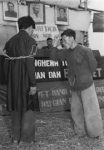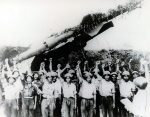
Vietnam is a south-east Asian nation bordered by China to the north, Laos and Cambodia in the west and the South China Sea to the east. In the mid-1800s, Vietnam was infiltrated and colonised by the French. For almost a century, French imperialists dominated Vietnam and exploited its people and resources for economic gain. The Japanese invaded Vietnam in 1940 and occupied it until the end of World War II. When the Japanese withdrew in 1945, Vietnam’s fate hung in the balance. A coalition of Vietnamese nationalists and communists moved to take control in August 1945, declaring independence and their intention to implement self-government. At this point, Vietnam became a focal point of the Cold War. Fearful that communists would seize control, the Allies intervened and returned the French to power in Vietnam. The result was a bloody war of independence that lasted eight years and ended with the French withdrawing from Vietnam. In 1954, an international conference in Geneva considered the future of the former French colony. As on the Korean peninsula years before, Vietnam was divided by a central border along the 17th parallel. North Vietnam would be ruled by nationalists and communists, while South Vietnam was ruled by a Western-backed regime headed by Ngo Dinh Diem.
In September 1954, the northern state declared itself the Democratic Republic of Vietnam. The world knew this new nation as North Vietnam. The ruling party of North Vietnam was the Lao Dong (‘Vietnamese Workers’ Party’), a self-declared communist party. Like other communist parties around the world, it had a large party membership, a Politburo and Secretariat, a Central Committee and party branches at provincial and village levels. The party’s leader, figurehead and ideological mentor was Ho Chi Minh. Born Nguyen Sing Cung in 1890, Ho studied abroad in France, where he was first exposed to Marxism. He attended the Paris peace conference in 1919 and lobbied delegates there for Vietnamese independence, without success. Rebuffed by Western democratic leaders, Ho drew closer to Marxist theology and moved to Moscow. He returned to Vietnam in 1941 to lead the Viet Minh, a nationalist group fighting against the Japanese occupation. During World War II, Ho and the Viet Minh worked closely with and received support from the United States Office of Strategic Services (OSS), the forerunner to the Central Intelligence Agency (CIA).

One of the toughest challenges facing the new regime in North Vietnam was increasing food production. The region they governed was mountainous and had only small tracts of arable land. Historically, northern Vietnam had never been self-sufficient, relying instead on imported rice and food from the south. The Lao Dong adopted policies that were strongly influenced by five-year economic plans in the Soviet Union and communist China. In 1957 Ho Chi Minh announced a “three-year plan for the development and reorganisation of the economy” (1958-60). This plan marked the implementation of socialism in North Vietnam. The Lao Dong initiated land reforms similar to those adopted in China in the early 1950s. All land, individual enterprises and privately-owned wealth were seized. Land reform was managed by Lao Dong cadres, who entered villages, gathered records and interviewed locals about traditional arrangements and power structures. Their main task was to identify dia chu (landlords), who had their land, homes and property confiscated and redistributed to the needy. Landlords accused of oppressive behaviours like murder, rape or assault were condemned as dia chu cuong hao gian ac (‘cruel and barbaric landlords’). They were treated as criminals and subject to public beatings and humiliation. As many as 50,000 landlords were executed by the Lao Dong or the villagers themselves.
“The system of re-education, according to the circular of the Council of Ministers, is to follow the line of “combining labor and political education”, and the regimen is to include eight hours of “productive labour” a day, two half-days set aside each week for “political study” with cultural classes in the evenings. Those who violate camp discipline, said Resolution 49, depending on the seriousness of the violation, “shall be prosecuted before a people’s court or sanctioned administratively”. Resolution 49 set the period of “educational reform” at three years, but allowed for early releases for those who “genuinely reform”, while stating that those who “refuse to reform” will have their period of “educational reform” extended.”
Ginetta Sagan, human rights activist
Landlords were not the Lao Dong’s only targets. In the mid-1950s Dong cadres began harassing Catholic priests and missionaries, Buddhist monks, the urban bourgeoisie, pro-French public servants, academics and intellectuals. Some suspects were arrested and carried off in the middle of the night. Some were immediately executed but thousands were sent for “re-education”. Outlined in the Lao Dong’s Resolution 49 (1961), re-education took place in concentration camps in the country’s far north and north-west. Detainees were placed in these camps without trial and remained there indefinitely, without a firm sentence or any hope of release. Thousands in the re-education camps died from prolonged beatings and abuse, malnutrition or exhaustion from hard labour. According to Vietnamese writer Hoang Van Chi, the Lao Dong’s campaign of land reform and re-education claimed as many as 500,000 lives. These excesses were admitted by Ho Chi Minh himself, who in 1956 acknowledged the campaign against landlords had gone too far and punished too many too severely. Lao Dong land reform policies also triggered opposition in some regions. In November 1956 approximately 20,000 peasants participated in an anti-government uprising in Nam Dan, near Ho’s own birthplace. It was crushed by North Vietnamese troops and around 6,000 peasants were killed. In 1959 Ho Chi Minh resigned as general secretary of the Lao Dong, though he remained in the party’s Politburo. The Western media continued to cultivate the impression that Ho was the dictatorial ruler of North Vietnam, though this was not the case.
By the end of 1960, the government’s economic reforms were beginning to yield results. North Vietnam boasted more than 40,000 agricultural co-operatives that occupied almost nine-tenths of available farmland. Rice production reached 5.4 million tons, more than double the amount produced before World War II. Production of other foods, including corn, sweet potatoes and beans, also grew significantly. The Lao Dong also set ambitious targets in other sectors, such as an 86 percent growth in traditional manufacturing and almost 170 percent growth in heavy industry. While these targets were not met, there was still rapid growth and progress in both areas. The Lao Dong benefited significantly from foreign aid from its socialist allies. With Chinese and Soviet materials and advice, the North Vietnamese constructed more than 100 new factories. By 1960, the North was able to mine its own coal, manufacture its own farm machinery, produce its own bricks and building supplies, build its own barges and ferries and generate its own electricity. This rapid industrialisation was not without its problems. The North was desperately short of skilled technicians and experts, such as engineers, architects and metallurgists to oversee its larger projects. The Lao Dong government was also desperately short of capital for infrastructure projects and cash for imports of raw materials.

With industrial growth came plans for military expansion. The Lao Dong accepted that military confrontation with South Vietnam and its Western backers was inevitable. The North’s military, the People’s Army of North Vietnam (PAVN, formed December 1944), was in desperate need of expansion and modernisation. Guided by Chinese and Soviet advisors, the PAVN was expanded and professionalised through the 1950s. In April 1960 the Lao Dong government introduced conscription and by the end of that year, the PAVN contained more than 160,000 men. The PAVN adopted standard Western military practices, such as a system of ranks, uniforms, training and regimental organisation. Its troops were trained in both conventional and guerrilla warfare. Military strategists began preparations for a war of reunification with US-backed South Vietnam. In 1959 the PAVN began preparing roads and supply lines to facilitate the movement of troops and equipment into South Vietnam. The most famous of these lines was the Ho Chi Minh Trail, a jungle track that allowed the movement of troops and supplies into South Vietnam.

In 1956, Lao Dong strategists headed by Le Duan began preparing for a war of reunification against the South. Using the Ho Chi Minh Trail and other routes, the North began moving infiltrators and supplies into South Vietnam. Once there, they began blending into the local population. The following year these agents initiated a campaign of terrorism, carrying out assassinations of local police and other officials. Their aim was to destabilise South Vietnam and incite a popular revolution to overthrow Ngo Dinh Diem and his corrupt regime. The South Vietnamese press described these subversives as Viet Nam Cong San (‘Vietnamese communist’) or Viet Cong for short. By 1959 there were an estimated 20 communist cells and 3,000 sleeper agents scattered around the South. Their numbers continued to grow, which allowed for the formation of a separate political-military movement, the National Liberation Front (NLF), in December 1960. A significant increase in Viet Cong attacks in 1961 prompted Washington to send thousands of military advisors to South Vietnam. This set the United States on the course to a full-scale war in Vietnam.

1. North Vietnam was a communist-ruled state governed by the Lao Dong. It was formed in 1954 after the First Indochina War and the decision to divide Vietnam at the 19th parallel.
2. The Lao Dong’s leader and mentor, Ho Chi Minh, was a key figure in Vietnamese nationalism. Ho studied in France and turned to Marxism after being rebuffed by Western powers in 1919.
3. The Lao Dong set about reforming North Vietnam’s economy on socialist lines. Measures were taken to improve food production while the economy was expanded and industrialised.
4. The Lao Dong was severe on landlords, who were dispossessed of their land and brutalised, while political opponents were arrested and detained in concentration camps for “re-education”.
5. North Vietnam also expanded and modernised its military, in preparation for a war of reunification with the South. In the mid-1950s it began sending communist infiltrators into South Vietnam to initiate a campaign of violence and terrorism. These agents were collectively known as the Viet Cong.
Content on this page is © Alpha History 2018-23. This content may not be republished or distributed without permission. For more ainformation please refer to our Terms of Use.
This page was written by Jennifer Llewellyn and Steve Thompson. To reference this page, use the following citation:
J. Llewellyn & S. Thompson, “North Vietnam”, Alpha History, accessed [today’s date], https://alphahistory.com/coldwar/north-vietnam/.
